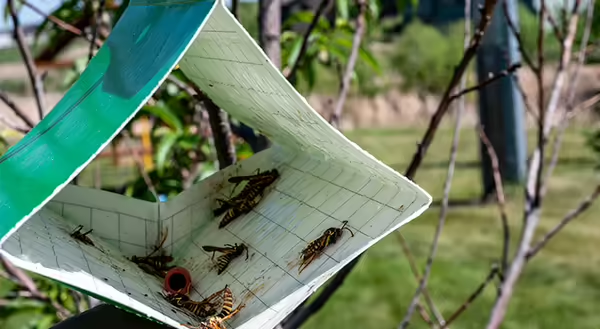
Apple and peach growers, it is that time of year again to order your pheromone traps for insect pest monitoring. These traps should be used through harvest to monitor for pests. Traps are useful for monitoring many insects of fruit crops, and the most important pests for Illinois growers are listed in Table 1.
What kind of traps work best?
Large plastic delta (LPD) traps work best. Several companies manufacture these traps, Trecé, Scentry, Suterra, and Alpha Scents. As a note, Trecé markets it as the Pherocon VI trap. This trap is quick to set up and easy to maintain; the sticky trapping surface is a card that slides in and out quickly and easily. If you bring the trap “shell” indoors at the end of the season, you can expect to get at least 2 to 3 years use from each trap (while replacing lures and liners as needed).
How do traps work?
Most of the insects listed in the table below are moths in their adult stage. For these moths, the trap must be baited with a pheromone lure – usually a small piece of rubber or plastic containing a synthetic blend of chemicals that is very similar to compounds used by female moths to attract males. When traps capture male moths, that indicates that females are also present, and mating and egg-laying are occurring. When ordering pheromone traps, you must order lures for the specific insect(s) you wish to monitor. Remember that although you may use the same type of trap to monitor different pests, you must use only a single lure per trap, it does not work to put lures for codling moth and dogwood borer in the same trap. Depending on the pest species, lures usually last 2 to 8 weeks (suppliers list the effective life of the lures they sell), so be sure to order enough lures for the whole season.
If you are growing apples in the northern half of Illinois, monitoring the flight of apple maggot flies is useful. Traps for apple maggot flies rely on appearance (especially the color and shape of a bright red apple) and the use of a food odor (“apple volatiles”) instead of a pheromone, and they are designed to capture female apple maggot flies ready to lay eggs on fruit. All the major suppliers of insect traps carry these kinds of traps. Growers should order the red spheres, tanglefoot, and the food lures recommended by the supplier. Apple maggot traps may be used without any food lures; spray thresholds vary based on use of food lures.
How many traps are needed for each pest species?
Guidelines often recommend at least 3 traps per pest species for any orchard up to 10 acres in size and 1 more trap for every 3 to 5 acres above 10. To monitor 50 acres of trees in 3 or 4 separate blocks, use 3 traps per block and at least 9-12 traps total … for each pest species. Always use at least 3 apple maggot traps (red spheres) per block of trees. See the table below regarding placement of traps. Check these traps and record counts in each at least twice per week.
If you have only one relatively small block of trees, you may want to order 3-trap kits available for each of the major pests. These kits generally include 3 lures per trap and since lures need to be replaced every 4 weeks, most Illinois growers will need another 2 lures per pest species per trap to get through the entire season.
If you operate an orchard larger than 10 to 15 acres, you'll need more traps, so contact a supplier and make plans to order in bulk. Long-life lures (last 8 weeks) are available for the codling moth and other species and are the best choice for almost all Illinois growers.
Table 1. Pheromone lures and traps available for purchase in Illinois
Crop | Pest | Area of Illinois | When to place traps? | Where do you hang the traps? |
Apples | Codling moth | Statewide | Bloom | Upper third of canopy, spaced throughout the block, including one somewhere near the upwind edge and one near the downwind edge. |
Dogwood borer | Statewide | Petal fall | 4 feet above the ground and within the tree canopy. (This height is very important, 1 foot higher or lower reduces attractiveness.) | |
Apple maggot | North of Springfield | June 15 | In the outer portion of the canopy of trees on the edge of the block ... VERY visible to adults flying into the block (remove foliage around the sticky red spheres). Hang in border rows or end trees nearest any woods or brush outside the block | |
Oriental fruit moth | Southern Illinois | Bloom | Upper third of canopy, but do not exceed 6-8 feet above ground. | |
Peaches | Lesser peachtree borer | Statewide | Bloom | Upper third of canopy, but do not exceed 5-6 feet above ground. |
Peachtree borer | Statewide | May 15 | Upper third of canopy, but do not exceed 3-4 feet above ground. | |
Oriental fruit moth | Statewide | Green tip to pink | Upper third of canopy, but do not exceed 6-8 feet above ground. |
Table 2. Midwestern suppliers of pheromone traps include:
| Supplier | Address |
| Great Lakes IPM | https://www.greatlakesipm.com/ 7563 N Crystal Rd Vestaburg, MI 48891-9746 email: glipm@greatlakesipm.com Phone: 989-268-5693 |
| Alpha Scents Inc | https://www.alphascents.com/ 360 S. Sequoia Parkway Canby, OR 97013 email: sales@alphascents.com phone: 503-342-8611 |
| Gemplers | https://gemplers.com/collections/pest-insect-control-pheromone-lures P.O. Box 5175 Janesville, WI 53547-5175 email: customerservice@gemplers.com Phone: 800-382-8473 |